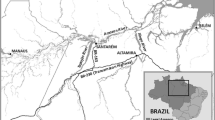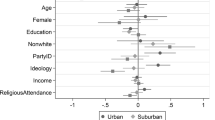Abstract
The forces driving periurban population growth and change vary, resulting in different scales of periurban development, and local differences will undoubtedly modify the social effect of population growth in the periurban zone. The aim of this paper is to assess the effect of recent population growth on the social structure of periurban communities. Drawing on results from surveys of migration to three study areas in the periurban region of Adelaide (South Australia), the paper examines the perceptions of recent migrants as distinct from the established residents, focusing on three key aspects associated with population growth: social integration, satisfaction and identification with the local area and local commitment.
Similar content being viewed by others
References
Beesley, K.B. 1988. Living in the urban field. Chapter 8 in P.M. Coppack, L.H. Russwurm and C.R. Bryant (eds),Essays on Canadian Urban Processes and Form III—The Urban Field. Department of Geography Publication Series No. 30. Ontario: University of Waterloo.
Beesley, K.B. (ed.). 1991.Rural and Urban Fringe Studies in Canada. Geographical Monographs No. 21. Ontario: York University.
Bowie, J.J.S. 1993. Land lost from agriculture: a dubious base for rural policy.Urban Policy and Research 11(4):217–229.
Bryant, C.R. and P.M. Coppack. 1991. The city’s countryside. Chapter 9 in T. Bunting and P. Filion (eds),Canadian Cities in Transition. Toronto: Oxford University Press.
Burnley, I.H. and P.A. Murphy. 1995. Exurban development in Australia and the United States: through a glass darkly.Journal of Planning Education and Research 14:245–254.
Carlson, E.S. and P.M. Coppack. 1991. An exploration of exurbanite service utilisation in the rural-urban fringe. Pp. 91–125 in K.B. Beesley (ed.),Rural and Urban Fringe Studies in Canada. Geographical Monograph No. 21. Ontario: Trent University.
Champion A.G. (ed.) 1989.Counterurbanization—The Changing Pace and Nature of Population Deconcentration. London: Edward Arnold.
Dahms, F.A. 1995. ‘Dying villages’, ‘counterurbanisation’ and the urban field—a Canadian perspective.Journal of Rural Studies 11(1):21–33.
Davis, J.S., A.C. Nelson and K.J. Dueker. 1994. The new burbs: the exurbs and their implications for planning policy.American Planning Association Journal 60:45–59.
Errington, A. 1994. The peri-urban fringe: Europe’s forgotten rural areas.Journal of Rural Studies 10(4): 367–375.
Ford, T. 1998. Population change in Adelaide’s peri-urban region: patterns, causes and implications. MA Thesis. Adelaide: Department of Geography, University of Adelaide.
Ford, T. 1999. Understanding population growth in the peri-urban region.International Journal of Population Geography 5:297–311.
Ford, T. Forthcoming. Differentiation of growth processes in the peri-urban region: a dual-scale approach to migration analysis in Adelaide’s peri-urban region.Urban Studies.
Forsythe, D.E. 1980. Urban incomers and rural change.Sociologia Ruralis 20:287–307.
Foyle, J. and P. Houston. 1992. Planning in the rural-urban fringe.Australian Planner 30(1): 45–50.
Griffin, T.L.C. 1965. The evolution and duplication of a pattern of urban growth.Economic Geography 41:133–156.
Heimlich, R.E. 1989. Metropolitan agriculture-farming in the city’s shadow.American Population Association Journal Autumn:457–466.
Hooimeijer, P. and B. van der Knaap. 1994. From flows of people to networks of behaviour.Nederlandse Geografische Studies 173:177–185.
Hudson, P. 1989. Change and adaptation in four rural communities in New England, NSW.Australian Geographer 20(1):54–64.
Jackson, J.T. and K. O’Connor. 1993. Beyond the fringe: social and physical planning problems in shires adjacent to Melbourne’s metropolitan statistical division.Urban Policy and Research 11(2):81–95.
Johansen, H.E. and G.V. Fuguitt. 1984.The Changing Rural Village in America—Demographic and Economic Trends Since 1950. Boston: Ballinger.
Joseph, A. and B. Smit. 1981. Implications of exurban residential development: a review.Canadian Journal of Regional Science 4(2):207–224.
Lewis, G.J. and D.L. Maund. 1976. The urbanization of the countryside: a framework for analysis.Geografiska Annaler 58B:17–27.
Murphy, P. and I. Burnley. 1996. Exurban migration. Pp. 242–258 in P. Newton and M. Bell (eds),Population Shift—Mobility and Change in Australia. Canberra: Australian Government Publishing Service.
Newby, H. 1979.Green and Pleasant Land? Social Change in Rural England. London: Hutchinson and Co.
Nucci, A. and L. Long. 1995. Spatial and demographic dynamics of metropolitan and nonmetropolitan territory in the United States.International Journal of Population Geography 1:165–181.
Pahl, R.E. 1965.Urbs in Rure. London: Weidenfeld and Nicolson.
Ploch, L.A. 1978. The reversal in migration patterns—some rural development consequences.Rural Sociology 43(2):293–303.
Price, M.L. and D.C. Clay. 1980. Structural disturbances in rural communities: some repercussions of the migration turnaround in Michigan.Rural Sociology 45(4):591–607.
Robinson, G.M. 1990.Conflict and Change in the Countryside—Rural Society, Economy and Planning in the Developed World. London: Belhaven Press.
Schwarzweller, H.K. 1979. Migration and the changing rural scene.Rural Sociology 44(1):7–23.
Smailes, P.J. 1997. Socio-economic change and rural morale in South Australia, 1982–1993.Journal of Rural Studies 13(1):19–42.
Thomas, D. 1990. The edge of the city.Transactions of the Institute of British Geographers (New edition) 15: 131–138.
Weber, B.A. and R.E. Howell. (eds). 1982.Coping with Rapid Growth in Rural Communities. Boulder: Westview Press.
Author information
Authors and Affiliations
Corresponding author
Rights and permissions
About this article
Cite this article
Ford, T. The social effect of population growth in the periurban region: The case of Adelaide. Journal of Population Research 18, 40–51 (2001). https://doi.org/10.1007/BF03031954
Issue Date:
DOI: https://doi.org/10.1007/BF03031954




